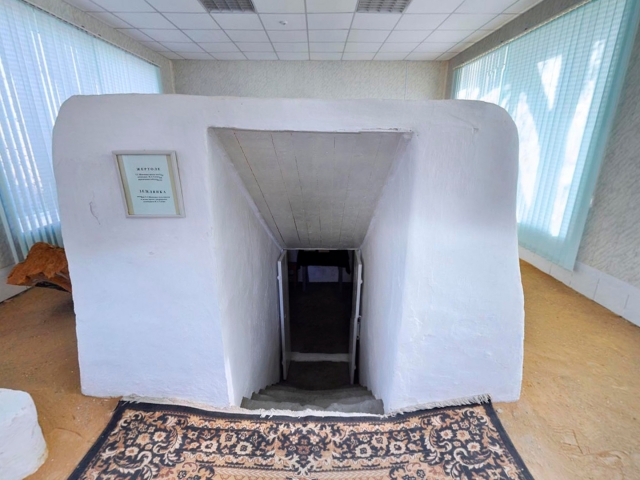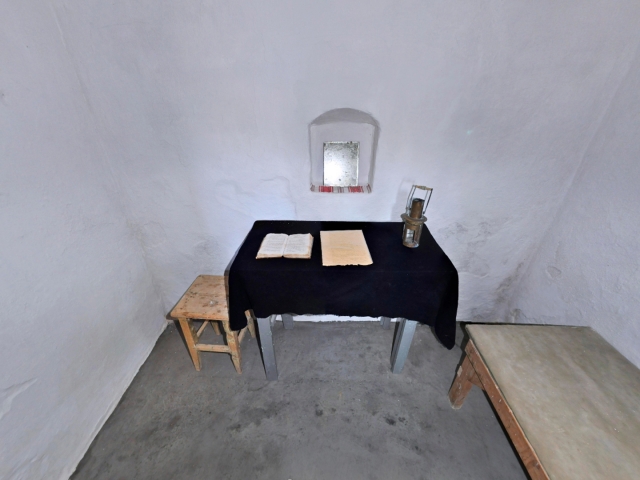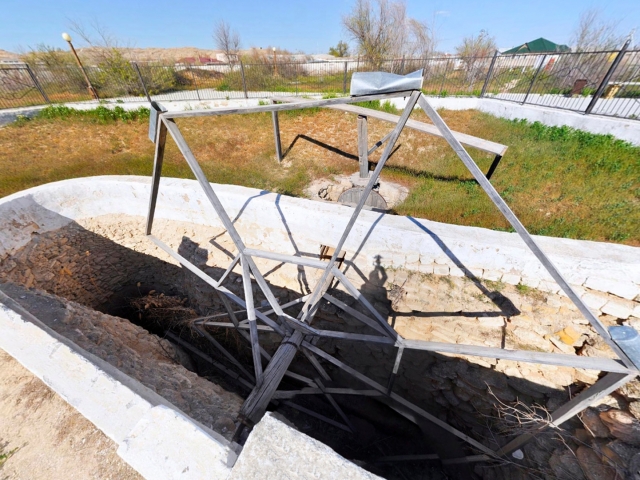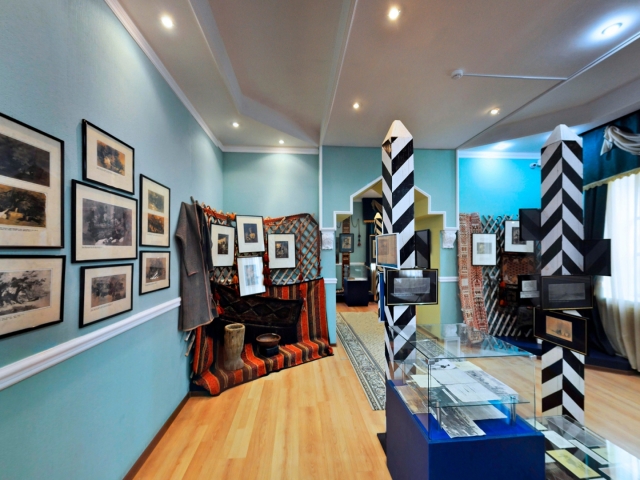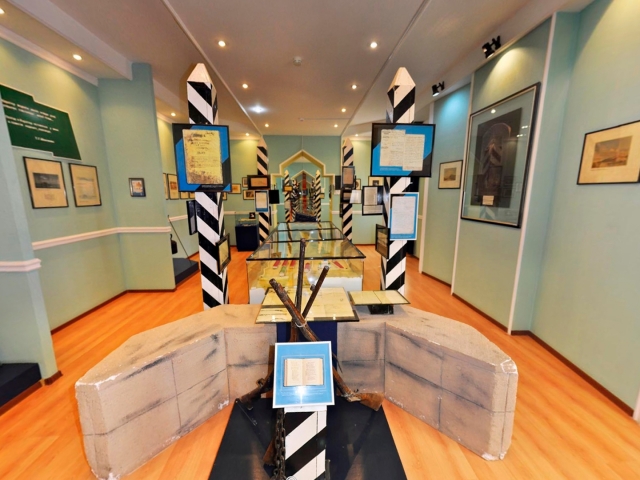Places
List of objects included in the map
Memorial of T. G. Shevchenko (1847-1857) (1932)
Location: 7 B.Mayauly street Shevchenko Park Fort-Shevchenko Tupkaragan district in Mangystau region.
Coordinates: N 44°30' 10.53" , E 50°15' 53.01"
Description of the Monument: In 1979 the study was conducted by expedition of institute 'Kazproektrestavratsiya' under the direction of architect M. Nurkabayeva, and restoration project was initiated. In 1981 expedition of 'Mangyshlakrestavratsiya' carried out restoration works and put a pavilion above the basement. By Order of the Minister of Culture and Sports of the Republic of Kazakhstan no. 119 dated March 30, 2015 the memorial was included in the governmental list of historical and cultural monuments of national importance. This memorial was included into the list of sacred objects as part of the project of regional importance Geography of Sacral Paces in Kazakhstan within the program 'Spiritual Renewal'.
Historical Data, Legends and Stories: Tarass Shevchenko is an outstanding Ukrainian poet, talented artist, playwright, ethnographer, political and social activist. In 1847 he was arrested for membership in the Cyrill-and-Methodius brotherhood and was deported to Kazakhstan for 10 years. In spring 1850 Shevchenko was again arrested for violating the tsar's 'Not to write and not to draw' Act that resulted in strict supervision in Novo-Petrovsk (1850-1857). In Novo-Petrovsk Shevchenko was not allowed to write and draw, and even pencils, ink, pens and paper were banned. His life changed significantly only in 1853, when Irakli A. Uskov was appointed the commandant of Novopetrovsk fort, who facilitated as much as possible the life of the exiled poet. Thanks to commandant Uskov, who created the conditions for creativity of Tarass Shevchenko, he was able to continue his work. Uskov not just respected Taras Shevchenko, he also became his friend. Tarass was released from duties and hard soldiers drills, got permission to walk outside the fortress walls from time to time and even overnight out of the barrack. Jeopardizing his career and life, knowing that he violated the strict prohibition of the tsar, Uskov, who was not alien to democratic beliefs of the poet, not only allowed Shevchenko to secretly write and draw, but also helped to send his drawings to his friends. During the exile in Novopetrovsk Fort Tarass Shevchenko created a great number of drawings, poems, several novels. Despite these difficult times, creativity of T. G. Shevchenko matured in Mangyshlak. The poet visited the Aral sea on the territory of Orenburg and spent 7 years on the Mangyshlak Peninsula. Due to stalemate in prison, he had to survive the harsh climate of this land 'deserts and rocks;' he called it the 'unlocked prison' and wrote to his friend 'There is nothing here, only desert.' The poet studied traditions, culture and everyday life of the Kazakh people in the Kazakh land. He participated in the expedition to the Aral sea. He took part in geological expeditions to the Karatau mountains.
In his paintings Tarass Shevchenko showed ethnographic details of the local Kazakhs and the nature of this land. He planted the first tree on the Mangyshlak Peninsula. This tree was called Tarass's willow. Activities of Tarass Shevchenko on the Kazakh land demonstrates friendship and brotherhood between peoples. This memorial and museum play an important role for the Kazakh and Ukrainian peoples. During his stay in Kazakhstan Shevchenko took an active part in geographical studies. The great poet was in friendly relations with the researchers of the Kazakh land - the famous scientist Karl Maksimovich Baer, traveler Karelin and Colonel Butakov, who was called Columbus of the Aral Sea, traveler and geographer Maksheyev and geologist Antipov. Tarass Shevchenko dedicated a lot of poems to the Kazakh land, drew and illustrated the life of the Kazakh people. He wrote about 20 novels, more than 100 poems and about 500 paintings. In his poems 'Dream', 'Axe was at the God's Door' and novels 'Twins', 'Convict' and 'Unfortunate' he described the life of the Kazakhs. In Novo-Petrovsk he wrote novel 'Maid-servant', 'Captain's Wife', 'Musician', 'Unfortunate', 'Twins', 'Artist'. Tarass devoted his talent and the most fruitful part of his life to painting everyday life, traditions and rituals of the Kazakhs of the peninsula. He painted such works as 'Sherkala', 'Baygushi', 'Reed', 'Kazakhs in a Yurt', 'Katia the Kazakh', etc. In 1925 the government of Kazakhstan decided to open a Museum of the great Ukrainian thinker, poet, artist Tarass G. Shevchenko in Fort Shevchenko city. In connection with the name of Shevchenko a special commission was arranged for collection of materials and exhibits, and it was opened on May 1, 1932. The Museum is located in the summer house of the former fortress commandant A. I. Uskov, who fully supported the disgraced poet. The Museum presents works of Shevchenko, copies of his diary, self-portraits, paintings and other documents. Many of the documents were brought from his homeland Ukraine. In 1981 Shevchenko Memorial Complex gained Republican status. The Complex includes a tree planted by the poet, dugouts, where he spent his days in exile, two wells with a Persian wheel and sculptures of the poet brought by his friends. In 1981 the Museum of Tarass Shevchenko became one of the first world-class museums in the country. The building is rectangular and consists of three large rooms. There was no heating because the house was used only in summer. A dugout survived and remained intact where the poet worked in his free time keeping it secret from the all-seeing tsarist officers. The poet had written a lot of poetry and paintings here. In the dugout the desk and the chair made of oak had been preserved. Over the stone table in front of the house the poet daily wrote his works, painted. He created paintings and portraits of beautiful landscapes as well as historical and domestic scenes. Shevchenko's particular interest to artefacts and ethnography of the Kazakh people became the basis for his paintings: architectural buildings, monuments, burial mounds located on the Mangistau Peninsula, including the Novopetrovsk fortress. To celebrate the 125th anniversary of Tarass Shevchenko in 1939 the town got the name Fort-Shevchenko. Currently this is a memorial house dedicated to the life and works of Tarass Shevchenko.
Source: Archives of Mangistau National Historical and Cultural Reserve.
Views: 6262
Маршрут
Hazret Yerzhan Burial
Shopan Ata Necropolis and Underground Mosque
Shakpak Ata Necropolis and Underground Mosque (14th–19th centuries)
Khatam-Ishan Mausoleum
The earliest structures here date back to the second half of the 17th c. The necropolis was developed in time and space in a circle, i.e. the most ancient constructions remained in the center. Out of the two extant domed mausoleums, the structure in the southern part of the necropolis is of particular interest. ...

